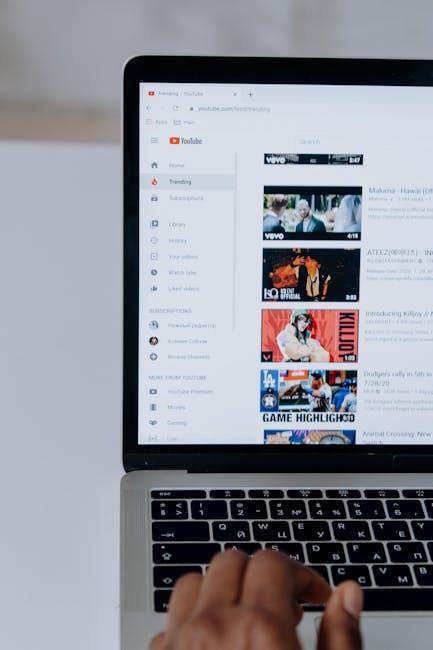Thinking about spicing up your app experience with YouTube videos? You’re not alone! Integrating video content can transform a dull interface into an engaging powerhouse. But before you dive into the deep end, there are some key considerations to keep in mind. From understanding copyright issues to optimizing user experience, there’s a world of knowledge waiting for you. Let’s unravel the essentials of using YouTube videos in your app, so you can captivate your audience and keep them coming back for more!
Understanding YouTube APIs: Navigating the Essentials for Seamless Integration
When it comes to integrating YouTube videos into your app, having a solid grasp of YouTube APIs can feel like unlocking a treasure chest. Think of APIs as the key that lets you interact with YouTube’s vast content library. With the YouTube Data API, you can easily fetch video details, user playlists, or channel information with just a few lines of code. This opens up a world of possibilities for your users, allowing them to search for videos directly from your app, watch them, and even add them to their favorite lists. It’s like having your own little YouTube universe right at your fingertips, right in your app!
Now, integrating these APIs may seem daunting at first, but breaking it down into steps can make it manageable. Start by setting up a project in the Google Developer Console and securing your API key. Once you’ve got that, you can dive into key functionalities like:
- Search for videos by keywords
- Embed videos seamlessly within your app
- Create playlists to enhance user engagement
Additionally, remember that understanding quota limits is essential—for every request you make to the API, there’s a cost associated with it. So, a little knowledge goes a long way in crafting a user-friendly video experience. Want to dive deeper? Checking out YouTube’s official documentation can provide nuanced insights and examples tailored to your needs.

Boosting User Engagement: How YouTube Videos Can Enrich Your App Experience
Integrating YouTube videos into your app isn’t just a flashy addition; it’s like adding a turbocharger to your vehicle’s engine. It can dramatically enhance user experience by providing rich, engaging content that resonates with users. Imagine this: instead of merely explaining a feature through text or static images, you showcase a dynamic video tutorial that clearly demonstrates it in action. Not only does this approach hold the viewer’s attention longer, but it also fosters a deeper understanding of your app’s functionalities. Here are some fundamental benefits to consider:
- Visual Learning: Videos cater to different learning styles, making it easier for users to grasp concepts.
- Increased Retention: Users are more likely to remember video content compared to plain text.
- Stronger Community Connection: Featuring user-generated content or testimonials builds trust and engagement.
Moreover, you can leverage YouTube’s vast library to complement your app’s content. For instance, say you’re developing a fitness app; embedding workouts or nutrition tips from reputable channels can add immense value. Not to mention, you can use classes and tags to style your video sections for a seamless look. Below is a simple example of how you can organize videos within your app:
| Video Title | Duration | Link |
|---|---|---|
| 5-Minute Morning Stretch | 5:00 | Watch Now |
| High-Protein Breakfast Ideas | 7:30 | Watch Now |
This strategic use of videos not only spices up your app but creates an interactive space where users can learn, grow, and engage more actively. So, why not harness the power of YouTube to elevate your app experience to the next level?

Best Practices for Embedding Videos: Making It Smooth and User-Friendly
When embedding videos, you want to ensure it’s as smooth as butter. Start by using the YouTube iframe embed code, which provides a clean and simple way to incorporate videos. Remember to adjust the width and height according to your app’s design. Think about responsive design—a video that looks great on desktop might not translate well to mobile. Make sure it scales down properly by adding CSS rules like max-width: 100%;. Also, creating a thumbnail or using the video’s preview image can enhance the user experience, letting users know what to expect. Nobody likes clicking on a generic link!
Don’t forget to give users control over their viewing experience. This means keeping the controls visible, so they can play, pause or adjust the volume easily. You can also consider enabling autoplay for engaging content but be cautious; it may annoy some users. Additionally, utilize captioning to make your videos more accessible. Implement custom call-to-action buttons below the video to encourage interaction or further actions, like subscribing to your channel or visiting your website. Keeping it engaging while straightforward will help captivate your audience effortlessly!

Monetization Opportunities: Unlocking Revenue Streams with YouTube Content
Diving into monetization through your app with YouTube content is like opening a treasure chest filled with gold. By embedding YouTube videos, you’re not just enriching your app’s experience; you’re also snagging potential revenue streams that can take your project to the next level. Here are a few ways you can make it rain:
- Ad Revenue: Channel the power of YouTube’s Partner Program and earn from ads shown on your videos. Every play counts, turning those views into dollars.
- Sponsorships: Collaborate with brands that align with your content, and get paid for featuring their products in your app.
- Affiliate Links: Tie in affiliate marketing by linking to products that you showcase in the videos. If users buy through your links, you’ll earn a tidy commission.
Understanding your audience is key to maximizing these opportunities. Use data analytics to see which videos resonate the most. This way, you can curate content that drives engagement and keeps users coming back for more. Consider crafting strategic partnerships—an inviting table of opportunities can make all the difference:
| Opportunity | Potential Revenue | Engagement Tactics |
|---|---|---|
| Ad Revenue | Varies on views | Optimize SEO, promote sharing |
| Sponsorships | Set fee per campaign | Feature in-app promotions |
| Affiliate Links | Up to 50% commission | Incorporate in video descriptions |

The Conclusion
So there you have it—your crash course on integrating YouTube videos into your app like a pro! Just think of this process as sprinkling a little extra magic into your project. With all the right tools at your disposal, you can elevate user experience and keep your audience coming back for more. It’s like adding whipped cream to your favorite dessert; it’s all about that extra touch!
Always remember to play fair with copyright, keep those API guidelines in mind, and ensure that your app is user-friendly. Whether you’re looking to educate, entertain, or inspire, YouTube is a goldmine of content that can make your app shine.
Now, go ahead and dive into this world of possibilities! If you have questions or want to share how you plan to use video in your next big idea, don’t be shy—drop your thoughts below. Happy coding!

